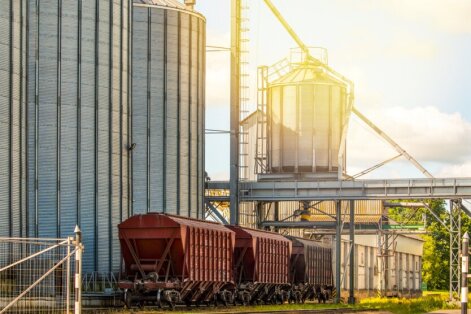There are opinions that for the growth of agricultural exports of Ukraine we need to start our own "big construction" of new elevator and port capacities. But the examples of civilized countries, including leaders in the export of agricultural products, tell a different story: first of all, it is important to have a clear and scheduled railway logistics for the delivery of grain to ports.
Ukraine has firmly occupied the niche of one of the largest guarantors of food security in the world. According to the Minister of Agrarian Policy Roman Leshchenko, the contribution of Ukrainian farmers to the global food market in 2021 is equivalent to the food of about 400 million people, not counting the population of Ukraine. The strategy for the development of the agricultural sector of Ukraine until 2030, announced by the Minister, is to provide food to 1 billion of the world's population.
These plans (increasing crop yields, gross grain harvest and agricultural exports) should include a set of measures in two strategic areas: the production of agricultural products and its logistics for export.
However, it will be possible to achieve ambitious goals provided that the two components of the system, the two partners - the agricultural business and the logistics business - correspond to each other. This means the similarity of values, principles of doing business, a common understanding of the effectiveness of business processes and compliance with each other in the pace of development and implementation of new technologies. Because any system functions at the level of its weakest link. And no matter how the strong link strives to become even stronger, more efficient, more modern, if the weak link continues to practice business approaches in the style of the 90s, then the result of cooperation between these two sectors will be at the level of the 90s.
The increase in the efficiency of the agricultural sector, which manifested itself in an increase in yields and exports over the past 10 years, has indicated all the weaknesses and vulnerabilities of rail logistics, which is the main and indispensable way to deliver Ukrainian grain to seaports for export.
The existing system of organization of railway logistics is morally obsolete today and is a constraint on the development of the economy and the export potential of the country. This manifested itself in several trends of recent years:
- the agricultural producer does not have the opportunity to receive the service of a carrier for the delivery of goods within the stipulated time
- crises are repeated every year, when in the autumn grain producers face a shortage of wagons and are forced to overpay for the opportunity to export the crop, and in the spring carriers face a shortage of cargo and are forced to dump
- the surplus of grain wagons created problems for carriers and does not allow the wagon building industry to develop
- chaos and irresponsibility in the organization of railway transportation create "bottlenecks" where corruption occurs
In the fall of 2021, the crisis in the rail transportation of agricultural products reached its climax, when the cost of a grain wagon soared 6 times within a few days. The main reasons for the rise in prices are the inability to plan the transportation of goods in advance, especially under forward export contracts, the lack of open information about the carrying capacity of Ukrzaliznytsia, and the lack of sufficient liability for logistics participants for non-compliance with their obligations.
According to various estimates, in the fall of 2021, Ukrainian farmers overpaid record amounts for the services of rail delivery of grown crops to ports: 1.5 billion hryvnia compared to the fall of 2019 and up to 3 billion hryvnia compared to the fall of 2020.
As a result of peak price surges in autumn 2021, the state-owned railway carrier received an additional income of UAH 478 million, but at the same time, Ukrzaliznytsia's competitors, who own 3/4 of the grain carrier fleet in Ukraine (19 thousand wagons compared to 7 thousand wagons of Ukrzaliznytsia), also received super profits. And the real "price" of these incomes, formed on the speculative market, is the financial loss of the agricultural sector, which accounts for the largest percentage of Ukraine's total exports - about 41% per year.
In early February, the Ukrainian Club of Agricultural Business, an industry association that unites more than 120 owners of agricultural enterprises, appealed to the head of the board of Ukrzaliznytsia Alexander Kamyshin with a call to take on the role of a funder, a legislator of reforms for the entire logistics market and to initiate new traditions, technologies and principles for organizing rail transportation.
Further development of events depends on the political will of the state as the main shareholder of Ukrzaliznytsia.
It is also important what impact the participants of businesses associated with the agricultural and logistics sectors will have on change initiatives. At industry events, there are opinions that for the growth of agricultural exports of Ukraine we need to start our own "big construction" of new elevator and port capacities.
But the examples of civilized countries, including leaders in the export of agricultural products, indicate that, first of all, it is important to have a clear and scheduled railway logistics for the delivery of grain to ports.
It is necessary to start by changing the principles of organizing logistics - to provide all market participants with equal access to the railway infrastructure, and to create an information platform in which carriers of all forms of ownership can interact.
The introduction of these changes will give three advantages to all participants in the Ukrainian agricultural export system. First, a concrete benefit to the agricultural sector. Each cargo will find its own wagon, and there will be no need to run after the wagon and raise rates. Grain carriers will be deployed efficiently throughout the year and will be less prone to spikes due to increased demand for railcars. Secondly, the elimination of corruption factors to gain access to transportation. And most importantly - the acquisition of the possibility of long-term planning of the load on all infrastructures - and this is an elevator, a railway, a port, a station, a port terminal. This infrastructure, like any other, has its own limiting resource. We propose to plan the load in such a way as to use it as efficiently as possible. Instead of setting up extra capacities that will be used 2 months a year.
Enterprises that live near railway businesses, ports and elevators will be able to plan their work for years in advance and will be able to see bottlenecks where resources need to be invested. The effective development of the carrying capacity of stations, hauls and ports will begin. Thoughtless projects that do not have their own cargo will not be built. Investments will be more justified.
Ukrzaliznytsia will also benefit from the changes. Today, work planning is happening “from the wheels”, and any operational changes critically increase operating costs. Only state-owned enterprises can afford such things, which, precisely for these reasons, lose out to private ones.
The introduction of a new transportation technology with long-term obligations is in line with the plans to change the operating model of Ukrzaliznytsia and the expectations of stakeholders to improve the efficiency of resources of all logistics participants, and will significantly reduce the costs of the transportation process for Ukrzaliznytsia itself, increase the predictability of the use of locomotives and locomotive crews, wagons, reduce their shortage for the transportation of given volumes, to increase the throughput and carrying capacity of hub and sorting, the entire railway network and near-railway infrastructures.
For example: one suitable grain-carrier of Ukrzaliznytsia made 24 profitable trips in the last two calendar years, against 45 trips, which makes a private car. Planning the load and operation of only this resource will allow Ukrzaliznytsia to transport the same volume with at least half the wagon fleet. The formation of a stable core of routes, trains in an open system will ensure the predictability and reliability of the entire railway infrastructure, and Ukrzaliznytsia in particular. And, in my opinion, this is much more important than the “random” millions of “profits” of UZ.
The agricultural sector in 2021 gave the highest percentage of GDP among all sectors of the Ukrainian economy - more than 10%. What would this figure be if the agricultural business had not lost 3 billion hryvnias due to the existing logistics system? With this money, new equipment would be bought, new technologies would be introduced, and territorial communities would receive additional income.
If the two components of exports, the agricultural sector and its logistics, come to a common denominator this year with the openness of business processes and the introduction of modern technologies, the ambitious goals of feeding 1 billion of the world's population will come true!
The author is an expert in the logistics market, adviser to the Head of the Board of Ukrzaliznytsia

























